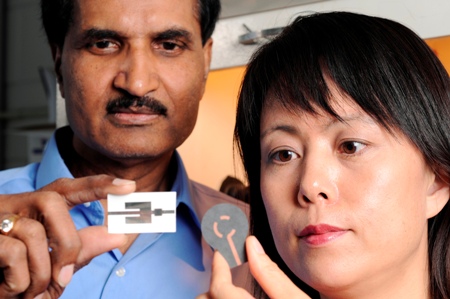Georgia Institute of Technology scientists have devised a wireless sensor prototype that can sense extremely low concentrations of ammonia, a major constituent of most of the explosives.
The carbon nanotube-based device, which is printed over paper or similar materials utilizing standard inkjet technology, can be installed in large numbers and finds applications to detect explosives for instance, in improvised explosive devices (IEDs).
Krishna Naishadham, who is the leader of the research team at the Georgia Tech Research Institute (GTRI) and a principal researcher, commented that the prototype comprises a communication device and a sensor in a compact, economical package that can work in almost all locations and can sense the presence of extremely low concentrations of ammonia down to 5 ppm.
 Krishna Naishadham, left, and Xiaojuan (Judy) Song display two types of wireless ammonia-sensing prototype devices.
Krishna Naishadham, left, and Xiaojuan (Judy) Song display two types of wireless ammonia-sensing prototype devices.
Xiaojuan (Judy) Song, a scientist at GTRI, fabricated the functionalized carbon nanotube-based sensing element and tested the same for sensitivity, Sensor data is transmitted through a wireless component, a resonant lightweight antenna. Professor Manos Tentzeris, who serves at Georgia Tech's School of Electrical and Computer Engineering, has developed the inkjet techniques utilized for the printing of the wireless component onto photographic paper.
Tentzeris stated that the antennas, circuits and components can be printed effectively using an innovative ink, which is an emulsion containing silver nanoparticles and can be uniformly printed at low temperatures of roughly 100° C. Optimal ink homogeneity and viscosity is achieved using a method known as sonication resulting in even deposition of the material and providing optimum operating efficiency for paper-based components.
Naishadham commented that the inkjet processes utilized for the fabrication of antennas, circuits and RF components can also be utilized for the deposition of the functionalized carbon nanotubes in order to fabricate the sensor. A conductive polymer that has sensitivity towards ammonia is coated over the carbon nanotubes to functionalize them. The functionalized carbon nanotubes undergo sonication process to produce a homogenous water-based ink. The resulting ink is then printed over antennas and RF components side-by-side for the fabrication of tiny wireless sensor nodes.
The prototype, with the utilization of RF technology, can sense trace amounts of explosive materials at a safe distance, which is called standoff detection. Solar cells, thin-film batteries and other energy-harvesting or power-saving technologies can be used as the power source for the wireless sensor nodes. The researchers are further studying the possibilities of enabling the sensor to work with no power.